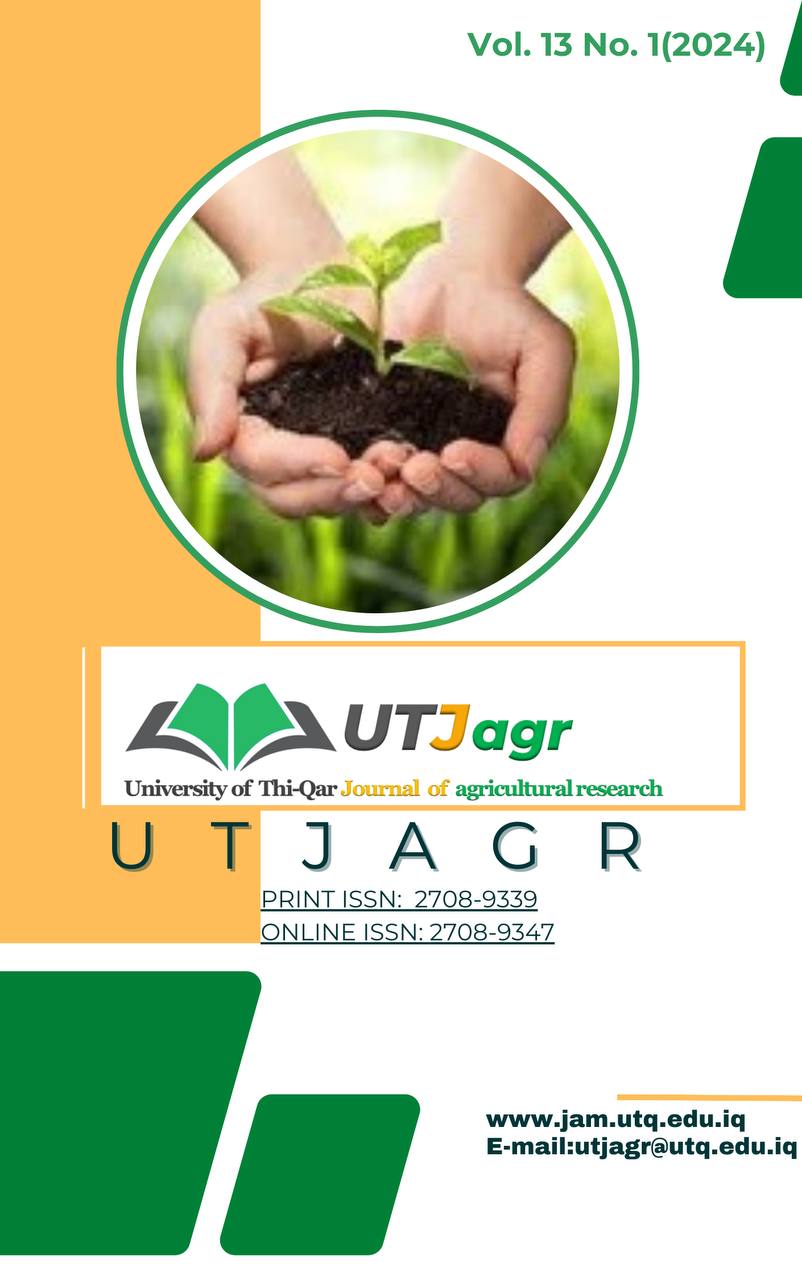molecular diagnosis of new reassortant infctious bursal disease virus in broiler chicken
DOI:
https://doi.org/10.54174/fr0kh866Keywords:
Infectious bursal disease, polymerase chain reaction (PCR), gross pathological lesionsAbstract
Infectious bursal disease, causing immunosuppression in chickens, poses significant financial challenges to the poultry sector. The onset of clinical symptoms and viral shedding is influenced by factors such as age, immunological condition, route of infection, and virus type. In this study, one hundred suspected infectious bursal disease (IBD) cases from nineteen chicken farms were examined, resulted in an overall positive rate of approximately 80%. Clinical signs in affected birds included ruffled feathers, decreased appetite, diarrhea, and a dirty vent, with hemorrhage seen on thigh muscles.
Identification was done based on molecular methods, polymerase chain reaction (PCR), and gross pathological observations. Ten samples were randomly selected and tested using specific IBD primers. All those samples were positive, despite the absence of a known cure for IBD, preventive measures, including immunization and rigorous biosecurity protocols, can help mitigate its impact. The study underscores the importance of molecular techniques by using special Primer Design for diagnosing reassortant very virulent IBDv sttain in natural infected broiler in Iraq(data don’t mention). offering insights into its prevalence and the effectiveness of preventive measures.
Downloads
References
Müller H, Scholtissek C, Becht H. The genome of infectious bursal disease virus consists of two segments of double-stranded RNA. Journal of Virology. 1979;31(3):584-9. https://doi.org/10.1128/jvi.31.3.584-589.1979
Wahome M, Njagi L, Nyaga P, Mbuthia P, Bebora L, Bwana M. Occurrence of antibodies to infectious bursal disease virus in non-vaccinated indigenous chicken, ducks and turkeys in Kenya. 2017.
Adino GW, Bayu M. Review of diagnostic and vaccination approaches of infectious bursal disease of poultry. Vet Med Open J. 2022;7:22-8. http://dx.doi.org/10.17140/VMOJ-7-164
McFerran J, McNulty M, McKillop E, Connor T, McCracken R, Collins D, et al. Isolation and serological studies with infectious bursal disease viruses from fowl, turkeys and ducks: demonstration of a second serotype. Avian pathology. 1980;9(3):395-404 https://doi.org/10.1080/03079458008418423.
Berg TPVD. Acute infectious bursal disease in poultry: a review. Avian pathology. 2000;29(3):175-94.
Müller H, Islam MR, Raue R. Research on infectious bursal disease—the past, the present and the future. Veterinary microbiology. 2003;97(1-2):153-65.
Raja P, Senthilkumar T, Parthiban M, Thangavelu A, Gowri AM, Palanisammi A, et al. Complete genome sequence analysis of a naturally reassorted infectious bursal disease virus from India. Genome Announcements. 2016;4(4):10.1128/genomea. 00709-16. https://doi.org/10.1128/genomea.00709-16
Petit Sp, Lejal N, Huet J-C, Delmas B. Active residues and viral substrate cleavage sites of the protease of the birnavirus infectious pancreatic necrosis virus. Journal of Virology. 2000;74(5):2057-66.
Lejal N, Da Costa B, Huet J-C, Delmas B. Role of Ser-652 and Lys-692 in the protease activity of infectious bursal disease virus VP4 and identification of its substrate cleavage sites. Journal of General Virology. 2000;81(4):983-92 https://doi.org/10.1099/0022-1317-81-4-983.
Dey S, Pathak DC, Ramamurthy N, Maity HK, Chellappa MM. Infectious bursal disease virus in chickens: prevalence, impact, and management strategies. Veterinary Medicine: Research and Reports. 2019:85-97. https://doi.org/10.2147/VMRR.S185159
Brandt M, Yao K, Liu M, Heckert RA, Vakharia VN. Molecular determinants of virulence, cell tropism, and pathogenic phenotype of infectious bursal disease virus. Journal of virology. 2001;75(24):11974-82. https://doi.org/10.1128/jvi.75.24.11974-11982.2001
Qi X, Gao H, Gao Y, Qin L, Wang Y, Gao L, et al. Naturally occurring mutations at residues 253 and 284 in VP2 contribute to the cell tropism and virulence of very virulent infectious bursal disease virus. Antiviral research. 2009;84(3):225-33. https://doi.org/10.1016/j.antiviral.2009.09.006
Qi X, Gao X, Lu Z, Zhang L, Wang Y, Gao L, et al. A single mutation in the P BC loop of VP2 is involved in the in vitro replication of infectious bursal disease virus. Science China Life Sciences. 2016;59:717-23. https://doi.org/10.1007/s11427-016-5054-1
Qi X, Zhang L, Chen Y, Gao L, Wu G, Qin L, et al. Mutations of residues 249 and 256 in VP2 are involved in the replication and virulence of infectious bursal disease virus. Plos one. 2013;8(7):e70982.
Ye C, Wang Y, Zhang E, Han X, Yu Z, Liu H. VP1 and VP3 are required and sufficient for translation initiation of uncapped infectious bursal disease virus genomic double-stranded RNA. Journal of Virology. 2018;92(2):10.1128/jvi. 01345-17. https://doi.org/10.1128/jvi.01345-17
Yang H, Wang Y, Ye C. Rapid generation of attenuated infectious bursal disease virus from dual-promoter plasmids by reduction of viral ribonucleoprotein activity. Journal of Virology. 2020;94(7):10.1128/jvi. 01569-19. https://doi.org/10.1128/jvi.01569-19
Alfonso-Morales A, Rios L, Martínez-Pérez O, Dolz R, Valle R, Perera CL, et al. Evaluation of a phylogenetic marker based on genomic segment B of infectious bursal disease virus: facilitating a feasible incorporation of this segment to the molecular epidemiology studies for this viral agent. PloS one. 2015;10(5):e0125853
Le Nouen, C., Rivallan, G., Toquin, D., Darlu, P., Morin, Y., Beven, V., de Boisseson, C., Cazaban, C., Comte, S., Gardin, Y., Eterradossi, N., 2006. Very virulent infectious bursal disease virus: reduced pathogenicity in a rare natural segment-B-reassorted isolate. J. Gen. Virol. 87, 209–216.
Le Nouen, C., Rivallan, G., Toquin, D. & Eterradossi, N. (2005). Significance of the genetic relationships deduced from partial nucleotide sequencing of infectious bursal disease virus genome segments A or B. Archives of Virology, 150, 313–325.
Li, K., Courtillon, C., Guionie, O., Allee, C., Amelot, M., Qi, X., Gao, Y., Wang, X. & Eterradossi, N. (2015). Genetic, antigenic and pathogenic characterization of four infectious bursal disease virus isolates from China suggests continued evolution of very virulent viruses. Infection, Genetics and Evolution, 30, 120–127.
Wei, Y., Yu, X., Zheng, J., Chu, W., Xu, H., Yu, X. & Yu, L. (2008). Reassortant infectious bursal disease virus isolated in China. Virus Research, 131, 279–282.
Li, K., Courtillon, C., Guionie, O., Allee, C., Amelot, M., Qi, X., Gao, Y., Wang, X. & Eterradossi, N. (2015). Genetic, antigenic and pathogenic characterization of four infectious bursal disease virus isolates from China suggests continued evolution of very virulent viruses. Infection, Genetics and Evolution, 30, 120–127.
Hon, C.C., Lam, T.Y., Drummond, A., Rambaut, A., Lee, Y.F., Yip, C.W., Ng, P.T.W. & Leung, F.C.C. (2006).
Phylogenetic analysis reveals a correlation between the expansion of very virulent infectious bursal disease virus and reassortment of its genome segment B. Journal of Virology, 80, 8503–8509.
Escaffre, O., Le Nouen, C., Amelot, M., Ambroggio, X., Ogden, K.M., Guionie, O., Muller, H., Islam, M.R. & Eterradossi, N. (2013). Both genome segments contribute to the pathogenicity of very virulent infectious bursal disease virus. Journal of Virology, 87, 2767–2780.
Zierenberg, K., Raue, R., Nieper, H., Islam, M.R., Eterradossi, N., Toquin, D. & Müller, H. (2004). Generation of serotype 1/serotype 2 reassortant viruses of the infectious bursal disease virus and their investigation in vitro and in vivo. Virus Research, 105, 23–34.
Jackwood, D.J., Sommer-Wagner, S.E., Crossley, B.M., Stoute,S.T.,Woolcock, P.R. &Charlton, B.R. (2011). Identification and pathogenicity of a natural reassortant between a very virulent serotype 1 infectious bursal disease virus (IBDV) and a serotype 2 IBDV. Virology, 420, 98–105.
Stoute, S.T., Jackwood, D.J., Crossley, B.M., Michel, L.O. & Blakey, J.R. (2019). Molecular epidemiology of endemic and very virulent infectious bursal disease virus genogroupsin backyard chickens in California, 2009-2017. Journal of Veterinary Diagnostic Investigation, 31, 371–377.
Wang, Q., Hu, H., Chen, G., Liu, H., Wang, S., Xia, D., Yu, Y., Zhang, Y., Jiang, J., Ma, J., Xu, Y., Xu, Z., Ou, C. & Liu, X. (2019). Identification and assessment of pathogenicity of a naturally reassorted infectious bursal disease virus from Henan, China. Poultry Science, 98, 6433–6444.
Pikula, A., Smietanka, K. & Perez, L.J. (2020). Emergence and expansion of novel pathogenic reassortant strains of infectious bursal disease virus causing acute outbreaks of the disease in Europe. Transboundary and Emerging Diseases, 67, 1739–1744.
Rasheed, B. Y., Hamad, M. A., & Isihak, F. A. (2024). Molecular study of resistance genes in Escherichia coli isolated from chronic respiratory disease cases in broilers. Iraqi Journal of Veterinary Sciences, 38(1), 119-124
Hassan Salah Mahdi, pathogenicity and antigenicity of some viral isolates. Infectious Fabricius gland disease in vaccinated chicken flocks in Iraq. Doctoral thesis. College of Veterinary Medicine, University of Mosul 1998
Jackwood D. Overview of Infectious bursal disease in poultry. MSD Veterinary Manual. 2018.
Habash, S., & D Kako, M. (2008). Gross histological changes in some lymphoid organs in broilers after vaccination against infectious bursal disease. Iraqi Journal of Veterinary Sciences, 22(2), 101-109
Rekha K, Sivasubramanian C, Chung I-M, Thiruvengadam M. Growth and replication of infectious bursal disease virus in the DF-1 cell line and chicken embryo fibroblasts. BioMed Research International. 2014;2014.
The telegy. Nawaf Inaam. Study of immune changes given to infectious bursitis of Fabricius vaccine in chickens (Master's thesis).' Mosul: University of Mosul
Al-Sheikhly F, Mutalib A, Rasheed D, editors. Infectious bursal disease in chickens. 4th annual conference of Iraq Veterinary Medical Association, Baghdad; 1978.
Wang Q, Hu H, Chen G, Liu H, Wang S, Xia D, et al. Identification and assessment of pathogenicity of a naturally reassorted infectious bursal disease virus from Henan, China. Poultry science. 2019;98(12):6433-44. https://doi.org/10.3382/ps/pez498
Kegne T, Chanie M. Review on the incidence and pathology of infectious bursal disease. 2012.
Teshome M, Fentahunand T, Admassu B. Infectious bursal disease (Gumboro disease) in Chickens. British Journal of Poultry Sciences. 2015;4(1):22-8.
Lukert P. Infectious Bursal Disease, InDiseases of Poultry, Eds., Saif, YM, AM Fadly, JR Glisson, LR McDougald, LK Nolan, and DE Swayne. Iowa State Press, Ames., Iowa; 2003.
Fauquet CM, Mayo MA, Maniloff J, Desselberger U, Ball LA. Virus taxonomy: VIIIth report of the International Committee on Taxonomy of Viruses: Academic Press; 2005.
Spackman E, Stephens CB, Pantin-Jackwood MJ. The effect of infectious bursal disease virus–induced immunosuppression on vaccination against highly pathogenic avian influenza virus. Avian diseases. 2018;62(1):36-44. https://doi.org/10.1637/11769-110717-Reg.1
Aktar M, Noor M, Kamal A, Rahman M. Scoring of bursal lesions in commercial broiler chickens infected with field IBD virus at Sylhet region of Bangladesh. Int Clin Pathol J. 2020;8(1):8-12.

Downloads
Published
Issue
Section
License

This work is licensed under a Creative Commons Attribution-NonCommercial-ShareAlike 4.0 International License.







1.png)

